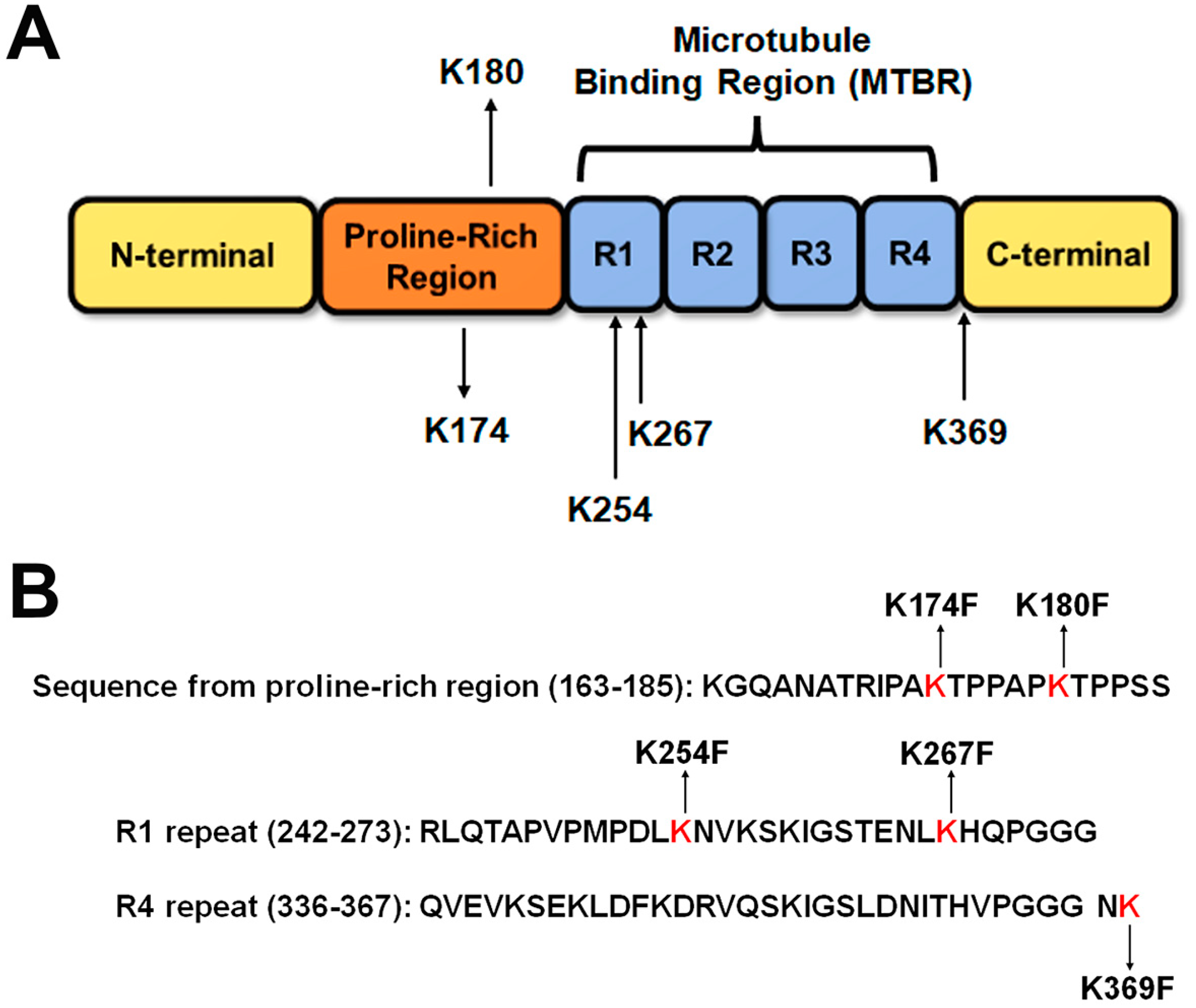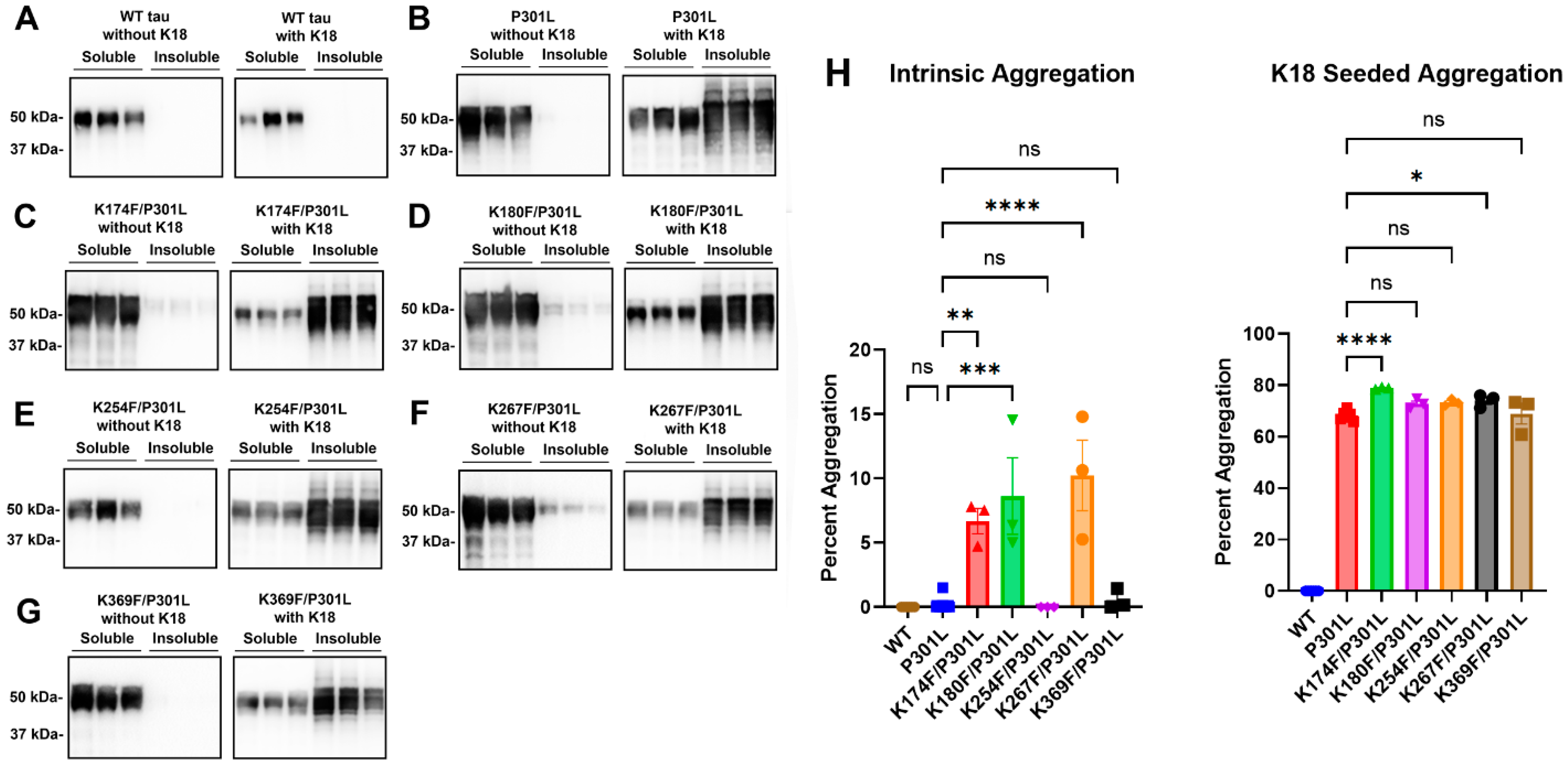Tau Lysine Pseudomethylation Regulates Microtubule Binding and Enhances Prion-like Tau Aggregation
Abstract
1. Introduction
2. Results
2.1. Site Selection for Methylmimetics
2.2. Tau Methylmimetics Regulate MT Binding
2.3. Single-Site Tau Methylmimetics within WT Tau Did Not Affect Tau Aggregation
2.4. Tau Methylmimetics Enhance Prion-like Seeded Aggregation in the Context of the P301L Tau Mutation
3. Discussion
4. Materials and Methods
4.1. K18 Protein Purification and Fibrillization
4.2. Plasmid Cloning and Site-Directed Mutagenesis
4.3. Cell Culture and Calcium Phosphate Transfection
4.4. Cell-Based MT Binding Assay
4.5. Cell-Based Tau Aggregation Assay
4.6. Immunoblotting
Author Contributions
Funding
Institutional Review Board Statement
Informed Consent Statement
Data Availability Statement
Conflicts of Interest
References
- 2022 Alzheimer’s Disease Facts and Figures. Alzheimers Dement. 2022, 18, 700–789. [CrossRef] [PubMed]
- Wang, Y.; Mandelkow, E. Tau in Physiology and Pathology. Nat. Rev. Neurosci. 2016, 17, 5–21. [Google Scholar] [CrossRef] [PubMed]
- Kadavath, H.; Hofele, R.V.; Biernat, J.; Kumar, S.; Tepper, K.; Urlaub, H.; Mandelkow, E.; Zweckstetter, M. Tau Stabilizes Microtubules by Binding at the Interface between Tubulin Heterodimers. Proc. Natl. Acad. Sci. USA 2015, 112, 7501–7506. [Google Scholar] [CrossRef] [PubMed]
- Weingarten, M.D.; Lockwood, A.H.; Hwo, S.Y.; Kirschner, M.W. A Protein Factor Essential for Microtubule Assembly. Proc. Natl. Acad. Sci. USA 1975, 72, 1858–1862. [Google Scholar] [CrossRef]
- Iqbal, K.; Liu, F.; Gong, C.-X. Tau and Neurodegenerative Disease: The Story so Far. Nat. Rev. Neurol. 2016, 12, 15–27. [Google Scholar] [CrossRef]
- Zhang, Y.; Wu, K.-M.; Yang, L.; Dong, Q.; Yu, J.-T. Tauopathies: New Perspectives and Challenges. Mol. Neurodegener. 2022, 17, 28. [Google Scholar] [CrossRef]
- Alquezar, C.; Arya, S.; Kao, A.W. Tau Post-Translational Modifications: Dynamic Transformers of Tau Function, Degradation, and Aggregation. Front. Neurol. 2020, 11, 595532. [Google Scholar] [CrossRef]
- Wesseling, H.; Mair, W.; Kumar, M.; Schlaffner, C.N.; Tang, S.; Beerepoot, P.; Fatou, B.; Guise, A.J.; Cheng, L.; Takeda, S.; et al. Tau PTM Profiles Identify Patient Heterogeneity and Stages of Alzheimer’s Disease. Cell 2020, 183, 1699–1713. [Google Scholar] [CrossRef]
- Funk, K.E.; Thomas, S.N.; Schafer, K.N.; Cooper, G.L.; Liao, Z.; Clark, D.J.; Yang, A.J.; Kuret, J. Lysine Methylation Is an Endogenous Post-Translational Modification of Tau Protein in Human Brain and a Modulator of Aggregation Propensity. Biochem. J. 2014, 462, 77. [Google Scholar] [CrossRef] [PubMed]
- Balmik, A.A.; Chinnathambi, S. Methylation as a Key Regulator of Tau Aggregation and Neuronal Health in Alzheimer’s Disease. Cell Commun. Signal 2021, 19, 51. [Google Scholar] [CrossRef]
- Bichmann, M.; Prat Oriol, N.; Ercan-Herbst, E.; Schöndorf, D.C.; Gomez Ramos, B.; Schwärzler, V.; Neu, M.; Schlüter, A.; Wang, X.; Jin, L.; et al. SETD7-Mediated Monomethylation Is Enriched on Soluble Tau in Alzheimer’s Disease. Mol. Neurodegener. 2021, 16, 46. [Google Scholar] [CrossRef]
- Huseby, C.J.; Hoffman, C.N.; Cooper, G.L.; Cocuron, J.C.; Alonso, A.P.; Thomas, S.N.; Yang, A.J.; Kuret, J. Quantification of Tau Protein Lysine Methylation in Aging and Alzheimer’s Disease. J. Alzheimers Dis. 2019, 71, 979. [Google Scholar] [CrossRef]
- Thomas, S.N.; Funk, K.E.; Wan, Y.; Liao, Z.; Davies, P.; Kuret, J.; Yang, A.J. Dual Modification of Alzheimer’s Disease PHF-Tau Protein by Lysine Methylation and Ubiquitylation: A Mass Spectrometry Approach. Acta Neuropathol. 2012, 123, 105. [Google Scholar] [CrossRef]
- Xia, Y.; Prokop, S.; Giasson, B.I. “Don’t Phos Over Tau”: Recent Developments in Clinical Biomarkers and Therapies Targeting Tau Phosphorylation in Alzheimer’s Disease and Other Tauopathies. Mol. Neurodegener. 2021, 16, 37. [Google Scholar] [CrossRef]
- Kontaxi, C.; Piccardo, P.; Gill, A.C. Lysine-Directed Post-Translational Modifications of Tau Protein in Alzheimer’s Disease and Related Tauopathies. Front. Mol. Biosci. 2017, 4, 56. [Google Scholar] [CrossRef] [PubMed]
- Huq, M.D.M.; Tsai, N.-P.; Khan, S.A.; Wei, L.-N. Lysine Trimethylation of Retinoic Acid Receptor-α. Mol. Cell. Proteom. 2007, 6, 677–688. [Google Scholar] [CrossRef] [PubMed]
- Chung, H.H.; Sze, S.K.; En Woo, A.R.; Sun, Y.; Sim, K.H.; Dong, X.M.; Lin, V.C.L. Lysine Methylation of Progesterone Receptor at Activation Function 1 Regulates Both Ligand-Independent Activity and Ligand Sensitivity of the Receptor. J. Biol. Chem. 2014, 289, 5704–5722. [Google Scholar] [CrossRef]
- Huq, M.D.M.; Ha, S.G.; Wei, L.N. Modulation of Retinoic Acid Receptor Alpha Activity by Lysine Methylation in the DNA Binding Domain. J. Proteome Res. 2008, 7, 4538–4545. [Google Scholar] [CrossRef] [PubMed]
- Neumann, M.; Schulz-Schaeffer, W.; Anthony Crowther, R.; Smith, M.J.; Spillantini, M.G.; Goedert, M.; Kretzschmar, H.A. Pick’s Disease Associated with the Novel Tau Gene Mutation K369I. Ann. Neurol. 2001, 50, 503–513. [Google Scholar] [CrossRef]
- Vallee, R.B. A Taxol-Dependent Procedure for the Isolation of Microtubules and Microtubule-Associated Proteins (MAPs). J. Cell Biol. 1982, 92, 435–442. [Google Scholar] [CrossRef]
- Kumar, N. Taxol-Induced Polymerization of Purified Tubulin. Mechanism of Action. J. Biol. Chem. 1981, 256, 10435–10441. [Google Scholar] [CrossRef] [PubMed]
- Hutton, M.; Lendon, C.L.; Rizzu, P.; Baker, M.; Froelich, S.; Houlden, H.; Pickering-Brown, S.; Chakraverty, S.; Isaacs, A.; Grover, A.; et al. Association of Missense and 5’-Splice-Site Mutations in Tau with the Inherited Dementia FTDP-17. Nature 1998, 393, 702–705. [Google Scholar] [CrossRef] [PubMed]
- Combs, B.; Gamblin, T.C. FTDP-17 Tau Mutations Induce Distinct Effects on Aggregation and Microtubule Interactions. Biochemistry 2012, 51, 8597–8607. [Google Scholar] [CrossRef] [PubMed]
- Xia, Y.; Sorrentino, Z.A.; Kim, J.D.; Strang, K.H.; Riffe, C.J.; Giasson, B.I. Impaired Tau-Microtubule Interactions Are Prevalent among Pathogenic Tau Variants Arising from Missense Mutations. J. Biol. Chem. 2019, 294, 18488–18503. [Google Scholar] [CrossRef] [PubMed]
- Strang, K.H.; Croft, C.L.; Sorrentino, Z.A.; Chakrabarty, P.; Golde, T.E.; Giasson, B.I. Distinct Differences in Prion-like Seeding and Aggregation between Tau Protein Variants Provide Mechanistic Insights into Tauopathies. J. Biol. Chem. 2018, 293, 2408–2421. [Google Scholar] [CrossRef]
- Skrabana, R.; Sevcik, J.; Novak, M. Intrinsically Disordered Proteins in the Neurodegenerative Processes: Formation of Tau Protein Paired Helical Filaments and Their Analysis. Cell. Mol. Neurobiol. 2006, 26, 1085–1097. [Google Scholar] [CrossRef]
- Bah, A.; Forman-Kay, J.D. Modulation of Intrinsically Disordered Protein Function by Post-Translational Modifications. J. Biol. Chem. 2016, 291, 6696. [Google Scholar] [CrossRef]
- Gorsky, M.K.; Burnouf, S.; Sofola-Adesakin, O.; Dols, J.; Augustin, H.; Weigelt, C.M.; Grönke, S.; Partridge, L. Pseudo-Acetylation of Multiple Sites on Human Tau Proteins Alters Tau Phosphorylation and Microtubule Binding, and Ameliorates Amyloid Beta Toxicity. Sci. Rep. 2017, 7, 9984. [Google Scholar] [CrossRef]
- Xia, Y.; Bell, B.M.; Giasson, B.I. Tau K321/K353 Pseudoacetylation within KXGS Motifs Regulates Tau–Microtubule Interactions and Inhibits Aggregation. Sci. Rep. 2021, 11, 17069. [Google Scholar] [CrossRef]
- Goode, B.L.; Denis, P.E.; Panda, D.; Radeke, M.J.; Miller, H.P.; Wilson, L.; Feinstein, S.C. Functional Interactions between the Proline-Rich and Repeat Regions of Tau Enhance Microtubule Binding and Assembly. Mol. Biol. Cell 1997, 8, 353–365. [Google Scholar] [CrossRef]
- Lee, G.; Neve, R.L.; Kosik, K.S. The Microtubule Binding Domain of Tau Protein. Neuron 1989, 2, 1615–1624. [Google Scholar] [CrossRef]
- Kellogg, E.H.; Hejab, N.M.A.; Poepsel, S.; Downing, K.H.; DiMaio, F.; Nogales, E. Near-Atomic Model of Microtubule-Tau Interactions. Science 2018, 360, 1242–1246. [Google Scholar] [CrossRef] [PubMed]
- Xia, Y.; Nasif, L.; Giasson, B.I. Pathogenic MAPT Mutations Q336H and Q336R Have Isoform-dependent Differences in Aggregation Propensity and Microtubule Dysfunction. J. Neurochem. 2021, 158, 455–466. [Google Scholar] [CrossRef] [PubMed]
- Zheng, L. An Efficient One-Step Site-Directed and Site-Saturation Mutagenesis Protocol. Nucleic Acids Res. 2004, 32, e115. [Google Scholar] [CrossRef]
- Xia, Y.; Prokop, S.; Gorion, K.-M.M.; Kim, J.D.; Sorrentino, Z.A.; Bell, B.M.; Manaois, A.N.; Chakrabarty, P.; Davies, P.; Giasson, B.I. Tau Ser208 Phosphorylation Promotes Aggregation and Reveals Neuropathologic Diversity in Alzheimer’s Disease and Other Tauopathies. Acta Neuropathol. Commun. 2020, 8, 88. [Google Scholar] [CrossRef]
- Vogelsberg-Ragaglia, V.; Bruce, J.; Richter-Landsberg, C.; Zhang, B.; Hong, M.; Trojanowski, J.Q.; Lee, V.M.-Y. Distinct FTDP-17 Missense Mutations in Tau Produce Tau Aggregates and Other Pathological Phenotypes in Transfected CHO Cells. Mol. Biol. Cell 2000, 11, 4093–4104. [Google Scholar] [CrossRef]
- Strang, K.H.; Goodwin, M.S.; Riffe, C.; Moore, B.D.; Chakrabarty, P.; Levites, Y.; Golde, T.E.; Giasson, B.I. Generation and Characterization of New Monoclonal Antibodies Targeting the PHF1 and AT8 Epitopes on Human Tau. Acta Neuropathol. Commun. 2017, 5, 58. [Google Scholar] [CrossRef]
- Schneider, C.A.; Rasband, W.S.; Eliceiri, K.W. NIH Image to ImageJ: 25 Years of Image Analysis. Nat. Methods 2012, 9, 671–675. [Google Scholar] [CrossRef] [PubMed]




Disclaimer/Publisher’s Note: The statements, opinions and data contained in all publications are solely those of the individual author(s) and contributor(s) and not of MDPI and/or the editor(s). MDPI and/or the editor(s) disclaim responsibility for any injury to people or property resulting from any ideas, methods, instructions or products referred to in the content. |
© 2023 by the authors. Licensee MDPI, Basel, Switzerland. This article is an open access article distributed under the terms and conditions of the Creative Commons Attribution (CC BY) license (https://creativecommons.org/licenses/by/4.0/).
Share and Cite
Xia, Y.; Bell, B.M.; Giasson, B.I. Tau Lysine Pseudomethylation Regulates Microtubule Binding and Enhances Prion-like Tau Aggregation. Int. J. Mol. Sci. 2023, 24, 8286. https://doi.org/10.3390/ijms24098286
Xia Y, Bell BM, Giasson BI. Tau Lysine Pseudomethylation Regulates Microtubule Binding and Enhances Prion-like Tau Aggregation. International Journal of Molecular Sciences. 2023; 24(9):8286. https://doi.org/10.3390/ijms24098286
Chicago/Turabian StyleXia, Yuxing, Brach M. Bell, and Benoit I. Giasson. 2023. "Tau Lysine Pseudomethylation Regulates Microtubule Binding and Enhances Prion-like Tau Aggregation" International Journal of Molecular Sciences 24, no. 9: 8286. https://doi.org/10.3390/ijms24098286
APA StyleXia, Y., Bell, B. M., & Giasson, B. I. (2023). Tau Lysine Pseudomethylation Regulates Microtubule Binding and Enhances Prion-like Tau Aggregation. International Journal of Molecular Sciences, 24(9), 8286. https://doi.org/10.3390/ijms24098286





